My goal is to keep happy and healthy chickens that do work for me. Building a small, mobile pen for them was my way to accomplish this.
For four years we kept four birds full-time in a modest four foot by eight foot pen. I moved the pen and chickens around our yard so the chickens could spread their manure near fruit trees (see photo above, taken a few winters ago).
I also put the pen under fruit trees or over vegetable beds so they could eat bugs:
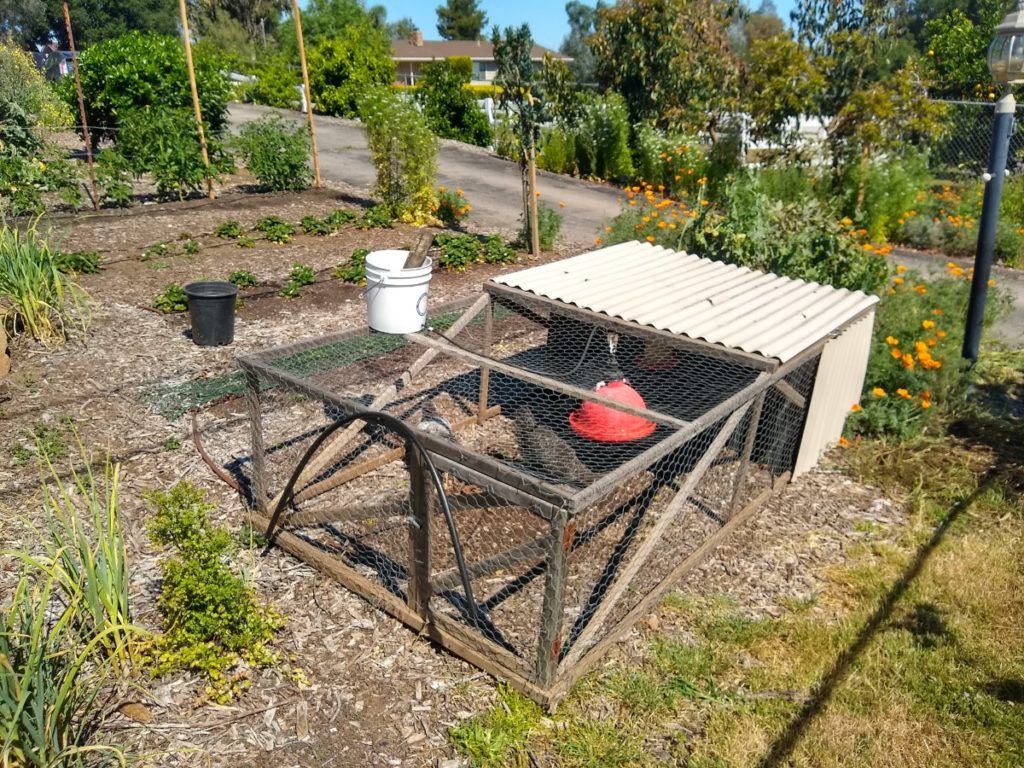
Or I kept the pen in one place for a while so the chickens could make compost for us:
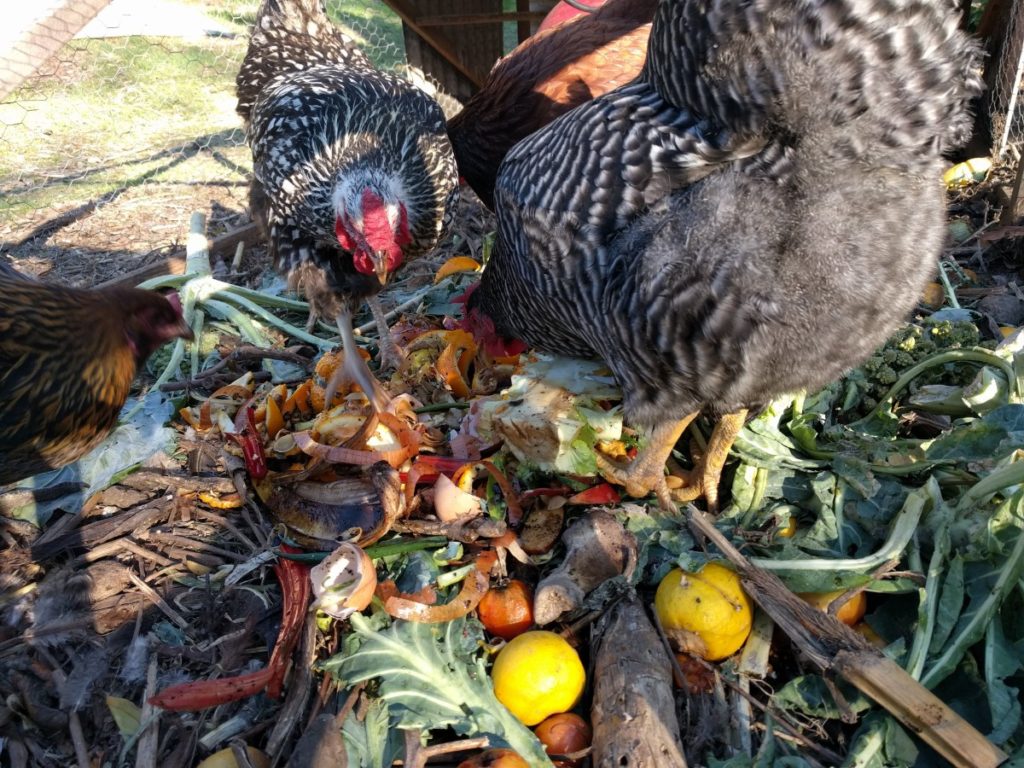
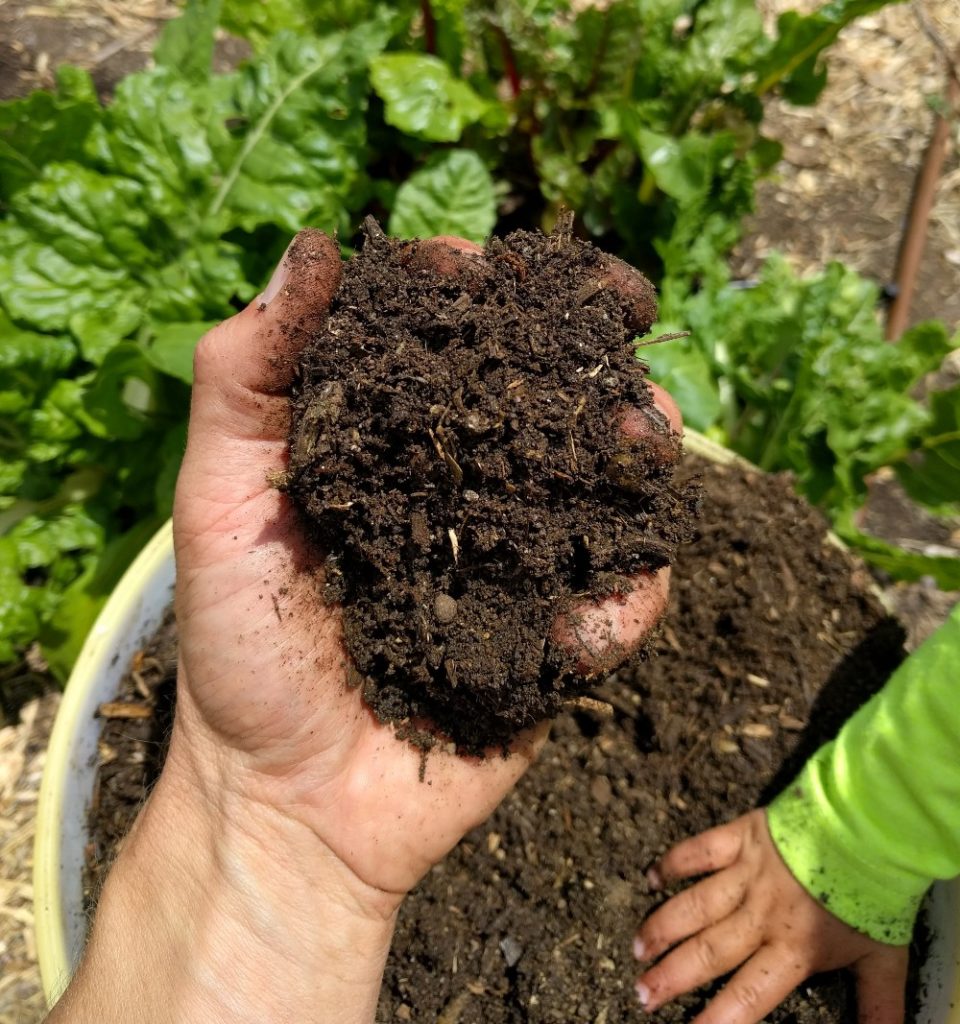
The pen and my routine with the chickens wasn’t perfect, but it worked — for all of us, I believe.
Maybe you’d like to try something similar in your yard. Here are some details about — and reasons for — the design of my mobile pen.
Size
The pen is four feet wide by eight feet long, and it is two feet high. My inspiration was to build a pen that was a slightly modified, miniature version of the pens that Joel Salatin builds for his pastured broilers. Salatin’s book Pastured Poultry Profits is a resource that you ought to own if you want to raise chickens on the move, so to speak.
Materials
As with Salatin’s pens, I used mostly 1-inch by 2-inch wood for the frame except for a couple of 2 by 2 pieces (center crossbeam, and bottom supports in front and back). Using wood any thicker only adds unnecessary weight.
I fastened all of the wood together with screws rather than nails, as Salatin wisely recommends, because that way the pen can flex as it moves. The nails would work their way loose.
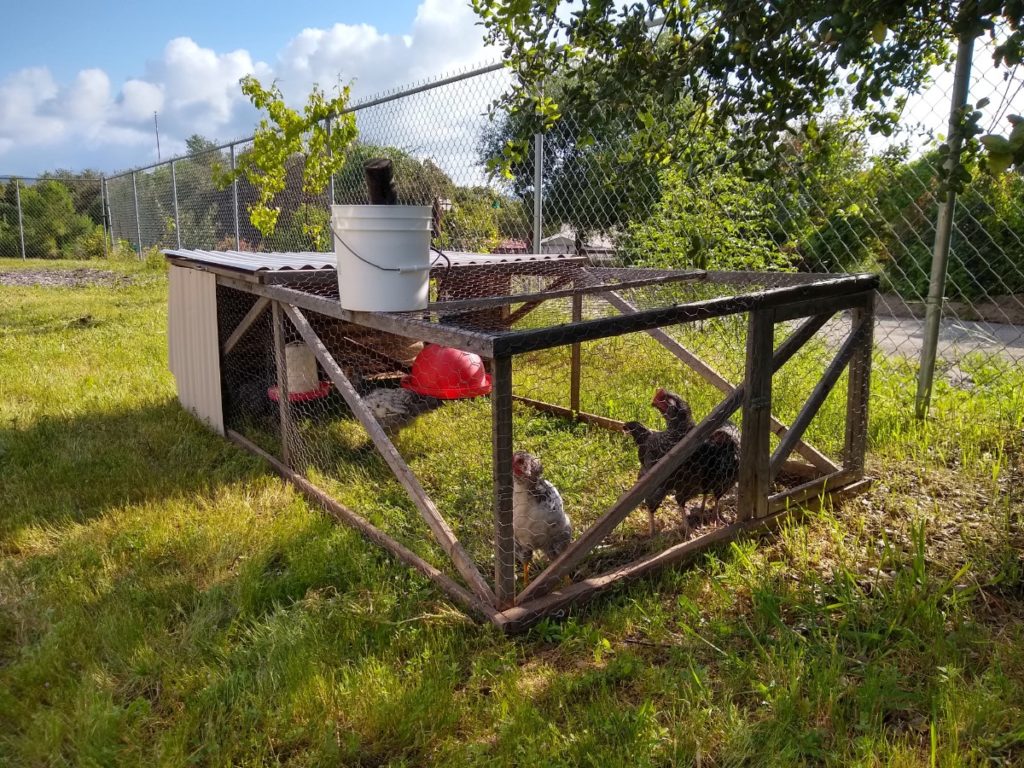
I wrapped most of the pen with 1-inch mesh poultry wire. Smaller mesh, like half-inch hardware cloth is more expensive and unnecessary for predator protection or keeping the chickens inside. Such tight mesh also prevents some bigger bugs such as grasshoppers from hopping into the pen and becoming a chicken snack (I’ve watched this happen).
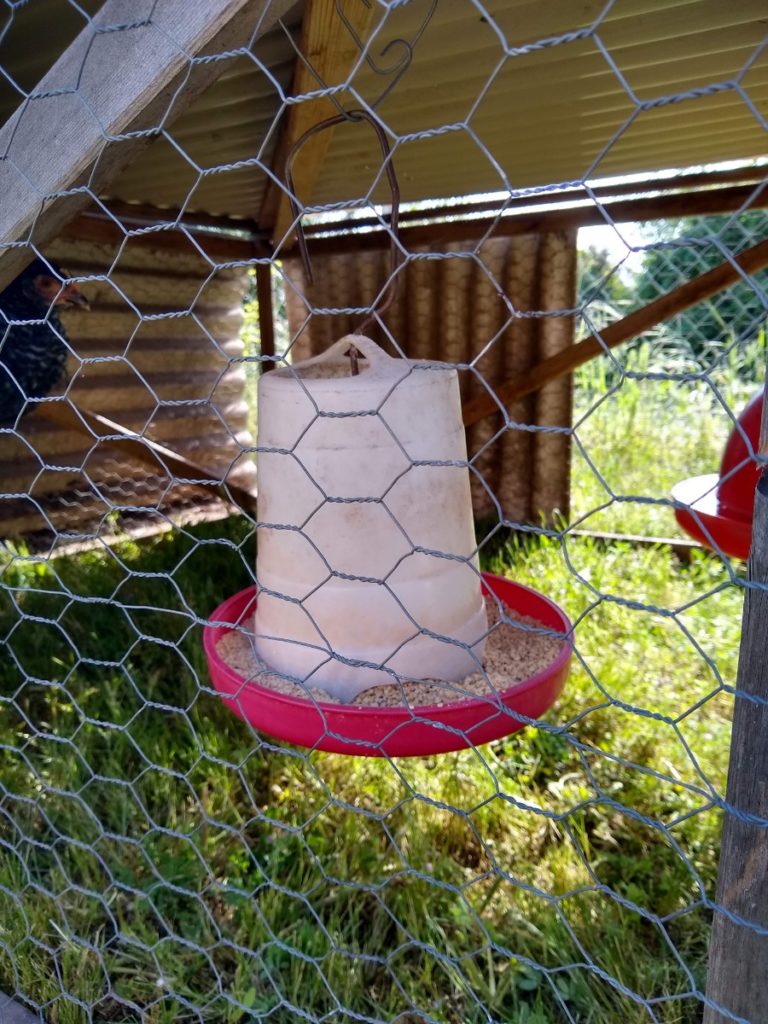
Roof and walls
In our Southern California climate, the chickens don’t need any specific cold protection. They just need to be able to stay dry and out of the wind during winter storms. You must balance this need for winter shelter with the need for ventilation during summer heat.
To accomplish all of this, I put a roof over only half of the pen’s top and I put walls around one end (back end) and only one third of each side, such that there is something like a small cave with an overhang at one end (the back end) of the pen. The waterproof material that I used for this roof and walls is Tuftex vinyl corrugated panels that I bought at Lowe’s. It is lightweight, tough, and flexible.
My pen has kept our chickens warm enough during temperatures slightly below freezing and it has kept them cool enough in temperatures as high as 118 degrees during that July 2018 heat wave.
Access
In order to collect eggs, clean the water, add food and so on, you need access to the inside of the pen. For access I made the roofed half of the top of the pen an unattached panel that can be lifted. At first, I put a hinge on one side but later I removed it because I wanted to be able to lift the panel from all sides. This roof panel is heavy enough that it stays in place except during high winds. If there are high winds, I just place the bucket of water on the roof to hold it down.
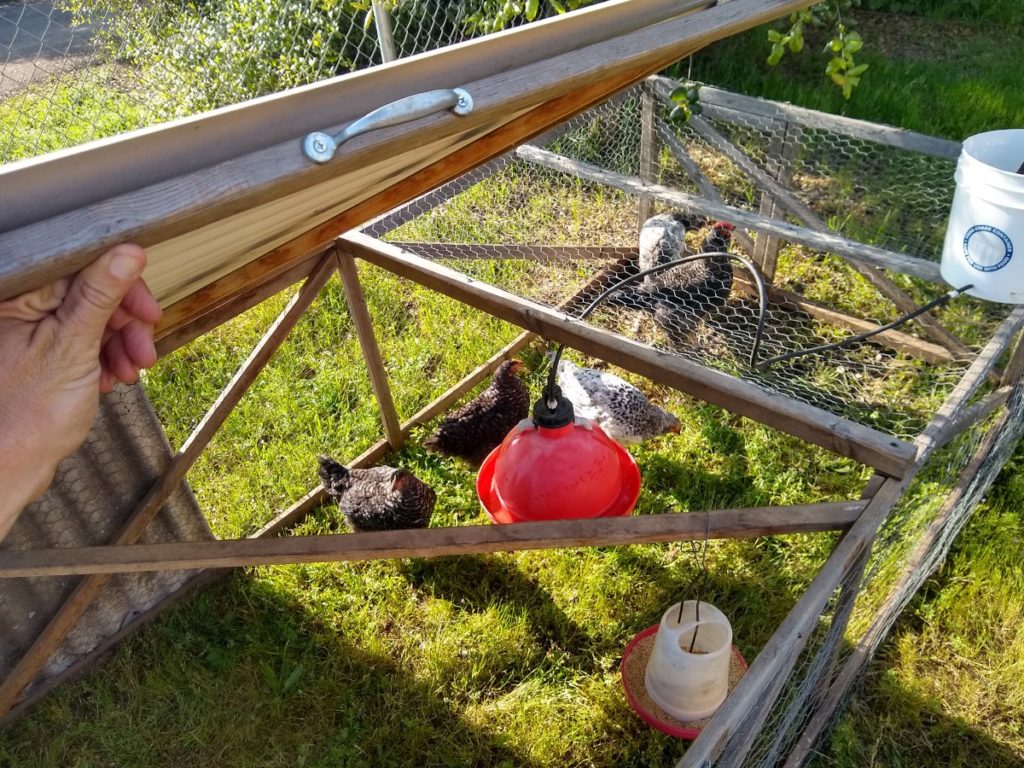
I also added a hinged door on the front of the pen, which is useful for letting the birds out in the evening to run around and for accessing that front part of the pen. Sometimes I want to put food scraps in that part of the pen, and sometimes the crazy birds decide to lay eggs there.
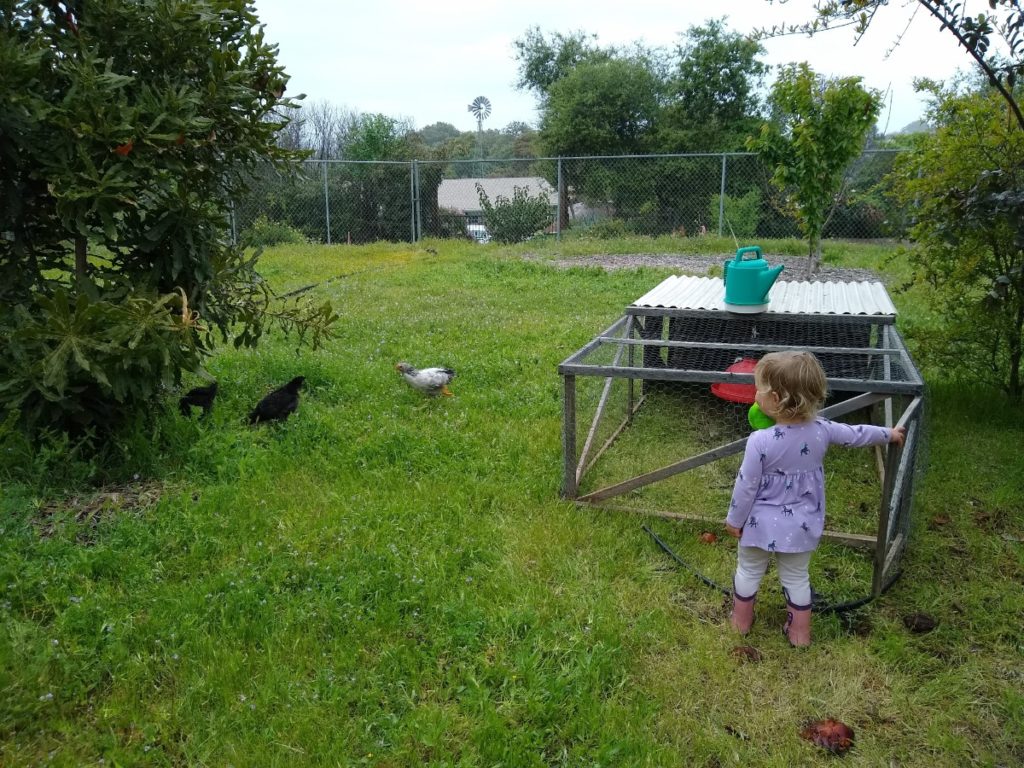
Water and feeder
The bucket of water on the roof is connected to a hanging waterer made by Plasson that is attached to the middle crossbeam. I also use a hanging feeder attached to the diagonal support under the roof in the back (so dew or rain doesn’t spoil the feed). Having water and food off the ground makes it very easy to move the pen. There is nothing to pick up or detach; you just start pulling.
On the front end of the pen I attached a wire to eye hooks. I wrapped the wire in a poly tube so that it was comfortable in my hands, and I could use it to pull the pen from place to place.
Wheels
Initially, I mounted old lawnmower wheels onto the back of the pen (see the photo at the top of this post), but I have since removed the wheels.
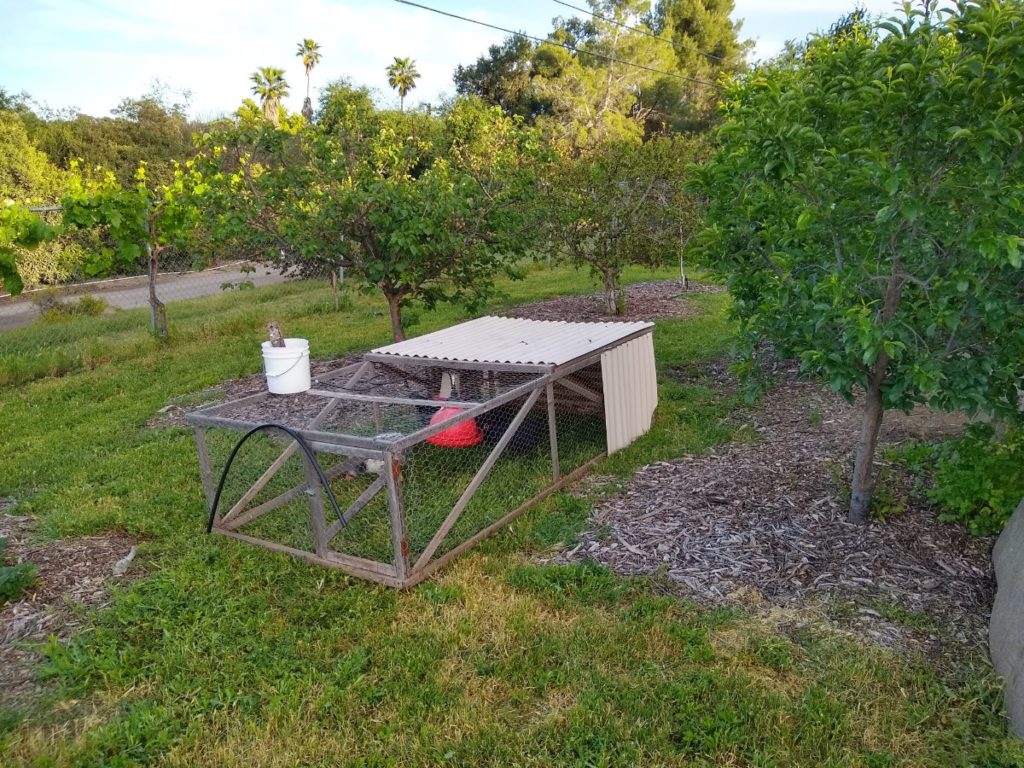
The problem with the wheels is that they raise the pen’s frame and create a gap. Chickens can sometimes squeeze out of that gap, and more importantly, predators can squeeze in. I did put some fencing there to cover the gap but it wasn’t entirely effective. I lost one chicken to a possum that squeezed into the pen by digging under the fencing by the wheels.
Since the pen is so light, I found that it slides easily without the wheels, as long as the pasture is not too tall or there are no big obstacles in the way such as large pieces of fallen fruit or wood.
Nestbox
Also at first, I put a nest box in the pen. It was a milkcrate that I attached to one wall, but the chickens continued to lay their eggs elsewhere in the pen too. The nestbox added weight and didn’t earn its keep so I removed the nest box. The hens proceeded to just lay eggs right on the ground usually somewhere under the covered back end of the pen.
Roost bar
Finally, I installed a roost bar across one corner of the back of the pen. It’s technically unnecessary. Without it the birds would just sleep on the ground. But chickens like to sleep up off the ground, and they poop continuously throughout the night so I figure it’s more hygenic to have them not sleeping on their poop.
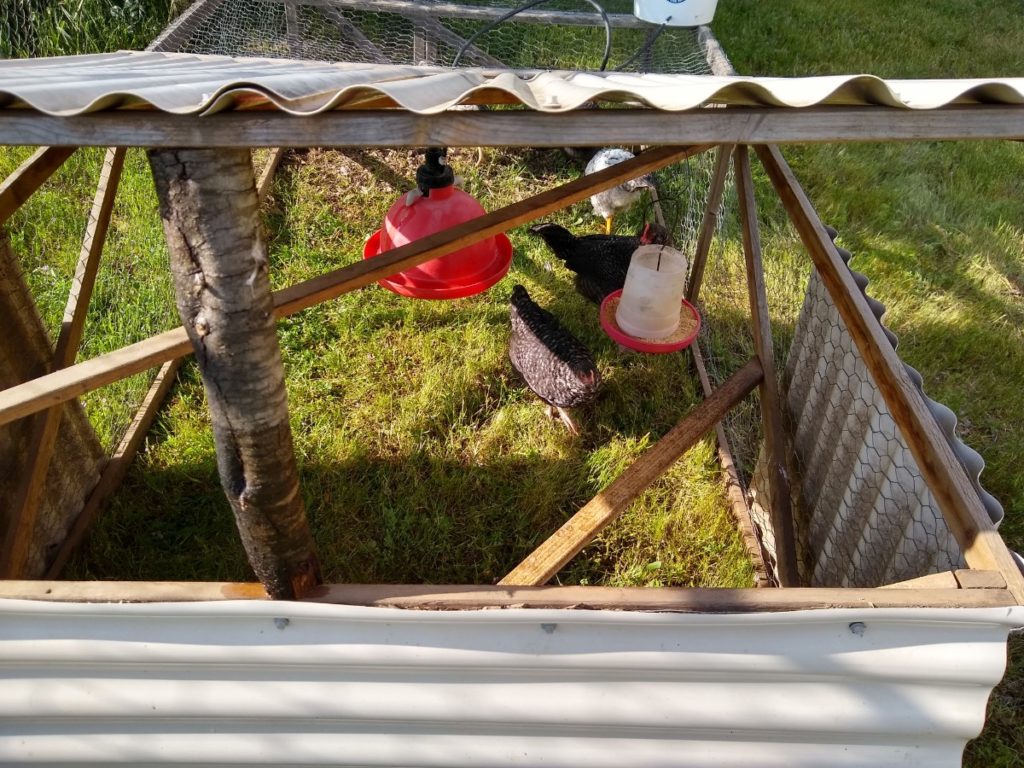
Cost
In total, the pen cost me about $130 for construction materials and the feeder and waterer. It is simple and light, and yet it is durable. After four years of constant movement, nothing has broken or needed repair except for a bit of poultry wire that came loose on one corner because I hadn’t stapled it well enough in the first place.
The next step
Why have I been speaking in the past tense? Since 2016 our family has grown, and we need more eggs so we’ve decided to keep a bigger flock. Today we have nine chickens. I’m experimenting with having them sleep in the small mobile pen but allowing them to roam inside a movable fence (from Premier 1) during most days. We’ll see how it goes. I’m still figuring out how to work this larger flock, which includes a rooster.
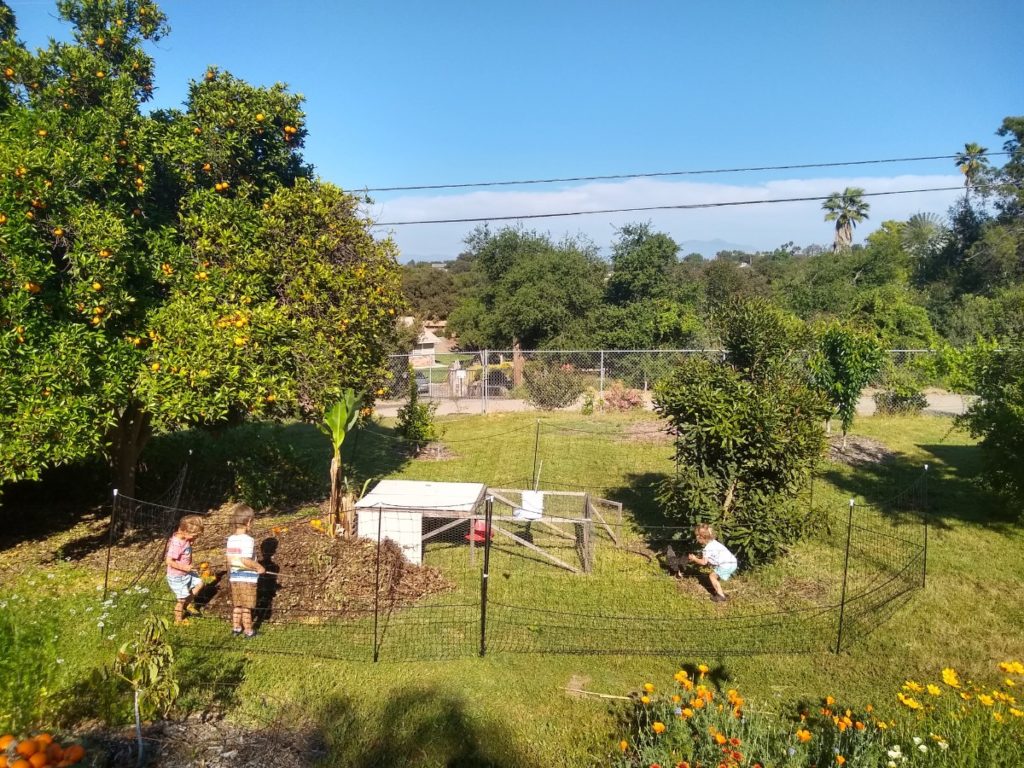
Other chicken posts I’ve written:
“Chickens eat bugs in the garden”
“Chickens: my garden’s little helpers”
“Grocery store vs. backyard chicken egg”
A list with links to all of my Yard Posts is HERE.




Thank you…this is really helpful!
Greg i like your approach to gardening and natural balance. You have pretty good size yard and can experiment with balanced approach to growing food.
Interestingly in your previous post you have mentioned passion fruit. i have three small bushes that especially last year had supported tons of Gulf Fritillary catterpillars and butterflies. Had tens of cocoons all over the yard. This bounty did not go unnoticed by some small flies or wasps that burrowed into the cocoons and destroyed 95% of them. Nature keeps things in balance if given opportunity and no “regulatory” measures by the government. Should be a lesson to all those politicians that try to control all aspects of our lives.
Hi Paul,
Thanks. I think your perspective is accurate. It is such a blessing to be able to watch the drama of nature unfold in the yard over the seasons, everyone competing and eating one another and getting along within their niches sometimes too.
The other day I watched a lizard snatch a honeybee that had landed on the ground, bite the head and thorax off and eat it. Then sometime later I watched a roadrunner snatch a lizard off a rock and gulp it down.
Hi Greg, I’ve discovered something that really seems to be working against possums, racoons, and gophers. At least so far. I’ve always burried our kitchen compost as well as shreded leaves, trimmings and any other organic waste to sheet compost. Some goes around my two avocado trees as well as our garden. Needless to say that rich layer that builds up is the perfect home for worms.
I bought some Very Hot, red pepper from our local India food market (Maybe $2-$3.). Inexpensive and super duper hot. You don’t want to cook with this, eat it, and please be careful with it.
I microwave 4 cups of tap water and get it really hot. Take the bowl out side and add immediatly two table spoons of the hot powder. Stir and let simmer for half an hour. I add half to a two gal watering can and pour this around the avocado mulch, or around plants in our garden and have not had any critters. I also pour a quart of this mixture down and gopher hole evidence.
So far there gone.
When I don’t feel like making up this super hot concoction I took a glass jar poked a few small holes in the cap and made a hot pepper shaker for just the powder. This works well and seems to be easier but you need to reapply after you water.
The benefit of this approach is it affect all three of these critters extremely sensitive sense of smell. I doubt it hurt them because the tinest wiff and they stay away. It’s also in expensive and doesn’t involve any chemicals.
Thanks for this, Ron. A critter has been chewing the chicken fence at night, and I suspect a rabbit or possum. I’m going to try spreading something like your concoction around the perimeter.
Greg, what a treasure of posts on so many practical topics for SoCal gardeners! This is my first response on your site. My wife & I have been talking chickens & coops for years but never getting down to business. We really like the mobile coop idea (Saladin, what an inspiration!). Your property looks beautifully flat. Our La Mesa yard is hills and rocks. There are flat, or flattish spots, but many terraces and narrow accesses & bumps and swells. SIZE & WEIGHT: About how heavy is your beautiful mobile coop? If I built your design but added handles, how hard would it be for my wife & me to lug & lift it about? Because of the narrow accesses, could the width be reduced to 3’ (so 3×8 feet) or would that compromise a happy hen-to-space ratio? And could the hens wander about outside as we lug? Next, CRITTERS: Don’t you get rats squeezing in through the chicken wire? Family in Visalia report that a hen of theirs lost her head through the chicken wire in their mobile coop (which is incidentally very heavy, maybe 10 or 12’ long). Head gone, but body inside the coop! I’m supposing 0.5” hardware clothe would add considerable weight. Thanks! Nick
Hi Nick,
Thanks. Although my yard does look flattish in photos, it is not. There is only a small flat area while the rest is hillside. It is certainly much easier to move the mobile chicken pen across the flat area though. More challenging than slope are small obstacles like rocks and sticks, which snag on the back bar of the pen as I pull it.
You can make a mobile pen much smaller, and therefore lighter. You just wouldn’t want to put as many chickens in it, at least not as a full-time home. I’d like to build one that is three feet wide by six feet long someday because that would fit better over my vegetable beds.
I don’t know how heavy my mobile pen is, but my six-year-old son can almost pull it by himself and he can lift the (lighter) front end by himself.
You can certainly let the chickens roam while you move the pen, but I tend not to do this because herding the chickens back into the pen is usually a pain unless it’s at sunset.
I’ve never noticed rats getting into the pen, but we’ve also never had a problem with rats in our yard generally.
I have heard that raccoons can reach into a coop and grab a chicken and eat it bit by bit through chicken wire, but I don’t know if this is really true. Regardless, I make sure my chickens sleep in the covered end of the pen where the chicken wire is covered by the vinyl roofing material so they are out of reach of such predators. Wherever you put a roost bar, that’s where the birds will almost surely sleep (except when they’re young and dumb).
Thanks, Greg, for the response and ideas. That gives me courage that your yard is less flat and more rocky than it appears! Also that you think that smaller dimensions could also work. Well, now I just gotta get down to it. Thanks again for the encouraging post.
Hey Greg,
Been lurking for a while and wanted to say thank you for everything you put out here! I garden up in San Luis Obispo county (Los Osos), and though it’s not quite Southern California, almost everything you put out has been helpful to me and I really appreciate it.
Not sure if you’re looking for a different mobile coop design to house the larger flock as well, but after several attempts at mobile coops with varying degrees of success (failure) I’ve landed on the “ChickShaw” and it has been great for me. Designed like a rickshaw, super easy to move over very rough terrain, lots of space for up to 20 chickens.
We have been using the Premier netting with it for a few years and it has been a winning combination.
If you’re interested you can see the details here: https://abundantpermaculture.com/mobile-chicken-coop/
P.S. Have you read Harvey Ussery’s book on chickens? It’s been invaluable to me and I thought you might appreciate it.
Hi Joe,
Great to hear that this stuff is useful to you in Los Osos. A few years ago, my wife and I headed north to attend a wedding near Solvang and we camped in one of the hike-in sites at Montana de Oro on the way up. We love that area. The fog can be surreal.
Justin Rhodes’s “ChickShaw” might be what I need with this larger flock. Thanks for the recommendation. (I greatly appreciate all of Rhodes’s videos and information. I especially enjoyed his “Great American Farm Tour.”)
Yes, I have read Harvey Ussery’s book. A friend lent it to me a while back, but I should buy my own copy. It is an excellent resource.
Yea, it’s a bit of a trick finding gardening advice here – we’re some weird mix of Southern California (the very northern tip of where commercial avocado growing is viable), and San Francisco (the fog! – like you said, it can be surreal). Add to that the huge variability of microclimates, and your head starts to spin. But we’re figuring it out, in part thanks to you.
When I first built the chickshaw, my girlfriend came out to test it out and thought I was tricking her it was so easy to lift and move. It really is a good design. I made some modifications to Rhodes design (roll-out nest boxes, metal roof, different roosts, etc), and it ended up making the balance TOO perfect – if you opened the roof, the whole thing would tip backwards! But it’s easy
As for Rhodes content in general, I certainly value some of it, but I’ve had enough run-ins with permaculture people who are make outlandish claims and can’t back them up, and also think they know the right way to do things after one two-week course, that I’m just too cynical to trust his content in general. But if it’s been valuable to you, I’m glad to hear it!
Yea, I have found it to be the one chicken book I go back to again and again. Your chicken tractor design reminds me a lot of the “Chicken Cruiser” in his book, which is why I asked.
Hi Joe,
Already ordered my copy of Ussery’s book after your reminding me of it the other day. And now that you mention his “Chicken Cruiser,” I think I recall a picture of it from the book where it’s parked over a vegetable bed. And yes, I think I did take a lot of ideas from his design. It’s just been a while so I don’t remember well. It’ll probably all come back to me when the book arrives.
I have only watched Rhodes’s “Great American Farm Tour” and some of his chicken videos. When I first went over to his website I was surprised it had permaculture in the name because he didn’t seem like a permaculture guy to me, and I’d never heard him mention permaculture. Your experiences with permaculture people sound very similar to mine. I try to be both honest and positive here on the website so I think I should leave it at that.
Yep, the picture of the Chicken Cruiser is over a garden bed, your memory is spot on!
Leaving it there with permaculture sounds good to me – I appreciate the honest positive tone and don’t want to disturb it.
P.S. Unrelated, but after reading your article on pluots I grabbed a Flavor Grenade scion at this year’s CRFG Scion Exchange and tried my hand at grafting, and it took! Thanks for the variety recommendation! Now I just need to wait for it to get a little bigger and graft a pollinator onto it…
Great news on the Flavor Grenade graft! You won’t be disappointed in that fruit, assuming it likes your climate.
I love this post so much! Thanks for another post on chickens. One of these days I’m going to have them. Hopefully sooner than later. Thanks Greg!
I saw these individual mobile chicken cage things on Twitter and thought you may want to try them…they look neat!!!
https://www.chickenorb.com/
That looks so funny but is a good idea. I imagine they would only work on flat ground. I’d love to try one.